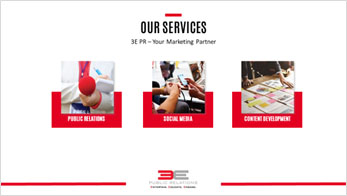Patrick Brightman - 04/23/2020
Summary: In today’s remote office environment, tools such as webinars are increasingly important tool to reach customers, prospects, and other colleagues. Here are seven tips to make the most out of them.
We’re all living in a new normal – both professionally and personally. On the business front, working remotely has required an adjustment as to the tools we use for marketing communications, from healthcare services and technology IP to CPG brands and everything in between.

One example of the changing marketing landscape is how webinars are a bigger ingredient in the overall communications mix. Like most things, there is a formula to conducting a successful webinar. Here are seven tips to get the best ROI from a virtual presentation.
Connecting with the Right Audience
Not surprisingly, the most important criterion is to secure qualified registered attendees. One way to achieve this goal is to partner with a media outlet, reputable industry association, or a distinguished brand that resonates with your target audience and shares your views. Among the advantages of this approach are:
- Existing (usually large) audience to recruit from
- Credible third party that can elevate your brand
- Expanded promotional opportunities to increase attendance and introduce your brand to new targets
Selecting the correct webinar partner has parallels with public relations. In PR, media relations is conducted after careful evaluation and research of media properties based upon audience and content that they post/broadcast/publish. Similarly, many PR firms have experience vetting associations and brands for co-promotions and other initiatives.
Focus On Key Takeaways
It’s important to hone in on primary points during a webinar. People will only retain a certain amount of information in any scenario, particularly one in which they are alone in an office. For this reason, a presenter should have a goal of having attendees remember no more than three primary messages. Anything beyond that and the risk increases that they lose interest or have limited recall.
The most effective approach is to introduce the messages during the webinar introductory/overview, have specific sections for each message and then repeat those points in the summary. It is a proven retention method.
Takeaways should be synergistic with the overall corporate messages. By following this approach, the brand essence will be retained. Additionally, it will allow target audiences to best recall the key messages, especially when they see them in other marketing communications initiatives, such as social media.
Once again, there is synergy between effective webinar elements and PR. Establishing concise and targeted messages are staples to any successful public relations campaign. Additionally, media training should be done with webinar presenters. It creates a seamless effect that allows the messages to be conveyed using conversational tone, rather than the presenter(s) reading from a script. A strong PR partner will be able to work with a brand to develop concise effective messages and conduct the necessary media training.
Integrate Video, Other Visual Elements
Integrating a short video(s) into the presentation creates an interactive element that effectively engages attendees. Additionally, countless studies reveal that the brain retains visuals faster and more effectively than straight text. Still images and charts/graphs are better than text alone but video creates a dynamic that can improve retention further.
The videos should be short (between 0:30 seconds and 2:00 minutes) and focus on showing visuals in a dynamic manner that goes beyond stock images/footage. Utilizing animation, 360-degree views, and similar effects creates a more memorable impact.
Another benefit is that video allows a second spokesperson to be part of a webinar, even if he/she is unable to participate in the live event. These spokespeople can be a corporate representative (creating a sense in attendees that they are important to the brand), engineering (explaining features/benefits at an advanced level), or a customer (real-world validity).
Incorporate Multiple “Voices”
In some instances, the webinar can have two presenters but that is not always possible. A new voice inherently revitalizes interest from attendees. It also helps to establish a flow and structure to a webinar, as there is a definitive start-end time to the participants.
Video can help achieve this goal. Another tool to create a “different” voice is to integrate quotes – either from recognized people or customers. Attendees will visualize the person if the saying is attributed to a well-known individual. If a customer quote is used, attendees will often create a picture of the type of person who would make that statement in their minds. It is usually based on one of his/her customers, a co-worker, or similar colleague.
Focus on Customer/Attendee Takeaways
When presenting, it is important to always remember to address attendees’ pain points and emphasize solutions to their problems. Do not focus solely on technology and specifications, nor should you be too brand-centric.
When mentioning technology or product attributes, make them relatable to attendees by explaining how those aspects improve real-world scenarios. This helps attendees paint a picture in their mind as to how their individual situation improves due to what is being presented in the webinar.
One size does not fit all with a webinar, so it’s vital to know the audience. Key messages remain constant but how they are presented must be the tailored to respective attendees, as they may be different target audiences. Each presentation should focus on how the topic specifically pertains those on the receiving end.
Keep Slides “Clean”

Each slide should be viewed as a “virtual index card” that is an overview of what will be discussed. If there is too much copy, attendees will not hear the presenter; they will concentrate on reading the words.
As mentioned previously, visuals are important for attendees to retain information. It is best to have a slide with minimal copy and larger images.
Additionally, when formatting slides, it is important to remember how they will be viewed. Attendees will watch the webinar via various devices (mobile phone, laptop, monitor, etc.). There is also no central method to access the webinar (i.e. different web browsers, new/old version of browser, or technology used for webinar). For these reasons, it is best to focus on taking a somewhat simplistic approach to the slide design.
Bring Some Levity
Even the most technical audience enjoys a chuckle. Presenters should interject real-world experiences that humanize themselves, as well as brings some humor to the webinar. It can be work-related or just a day-in-the-life but it should help create a connection between presenter and attendee. This is particularly true with a webinar, as a true face-to-face element does not exist, placing greater importance on establishing an emotional relationship.
If you are looking for webinar best practices or ways to maintain conveying your message to target audiences in any business climate, feel free to reach out to me. 
